Security and Risk Analysis of Blockchain and Cryptocurrency
VerifiedAdded on 2023/06/11
|17
|5254
|390
Literature Review
AI Summary
This literature review delves into the security and risk analysis of blockchain and cryptocurrency within the financial market. It begins by establishing the background of blockchain technology and its applications beyond cryptocurrencies, including smart contracts. The review examines how blockchain can transform financial markets by streamlining transactions, reducing counterparty and operational risks, and potentially replacing traditional intermediaries. It also addresses the legal and regulatory challenges associated with blockchain, emphasizing the need for a balance between innovation and stability. Furthermore, the review explores the potential of smart contracts to automate and enforce agreements, enhancing security and reducing transaction costs. It also discusses risk mitigation strategies and the importance of understanding the market dynamics of cryptocurrencies. The review concludes by highlighting the potential benefits and challenges of blockchain and cryptocurrency in the financial sector.
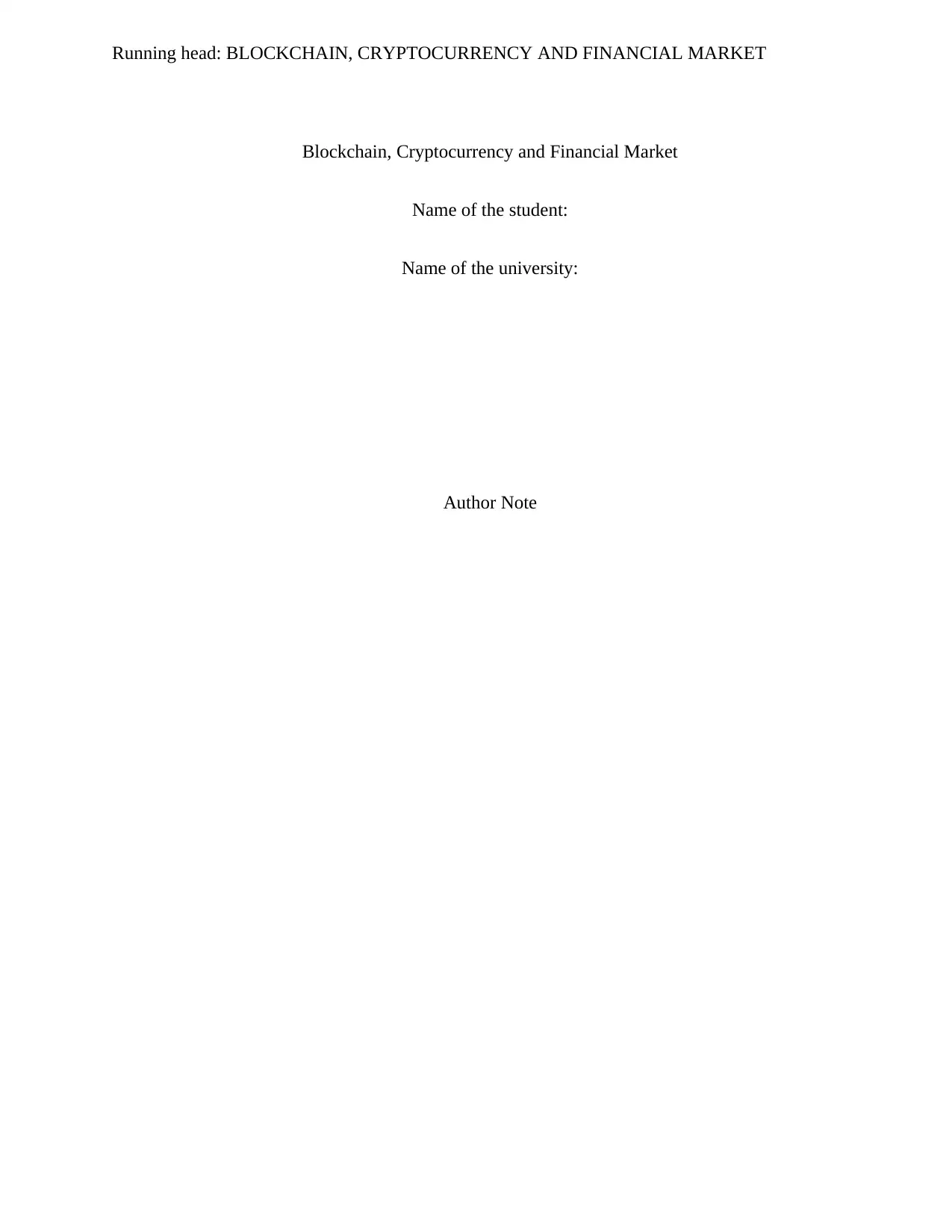
Running head: BLOCKCHAIN, CRYPTOCURRENCY AND FINANCIAL MARKET
Blockchain, Cryptocurrency and Financial Market
Name of the student:
Name of the university:
Author Note
Blockchain, Cryptocurrency and Financial Market
Name of the student:
Name of the university:
Author Note
Paraphrase This Document
Need a fresh take? Get an instant paraphrase of this document with our AI Paraphraser
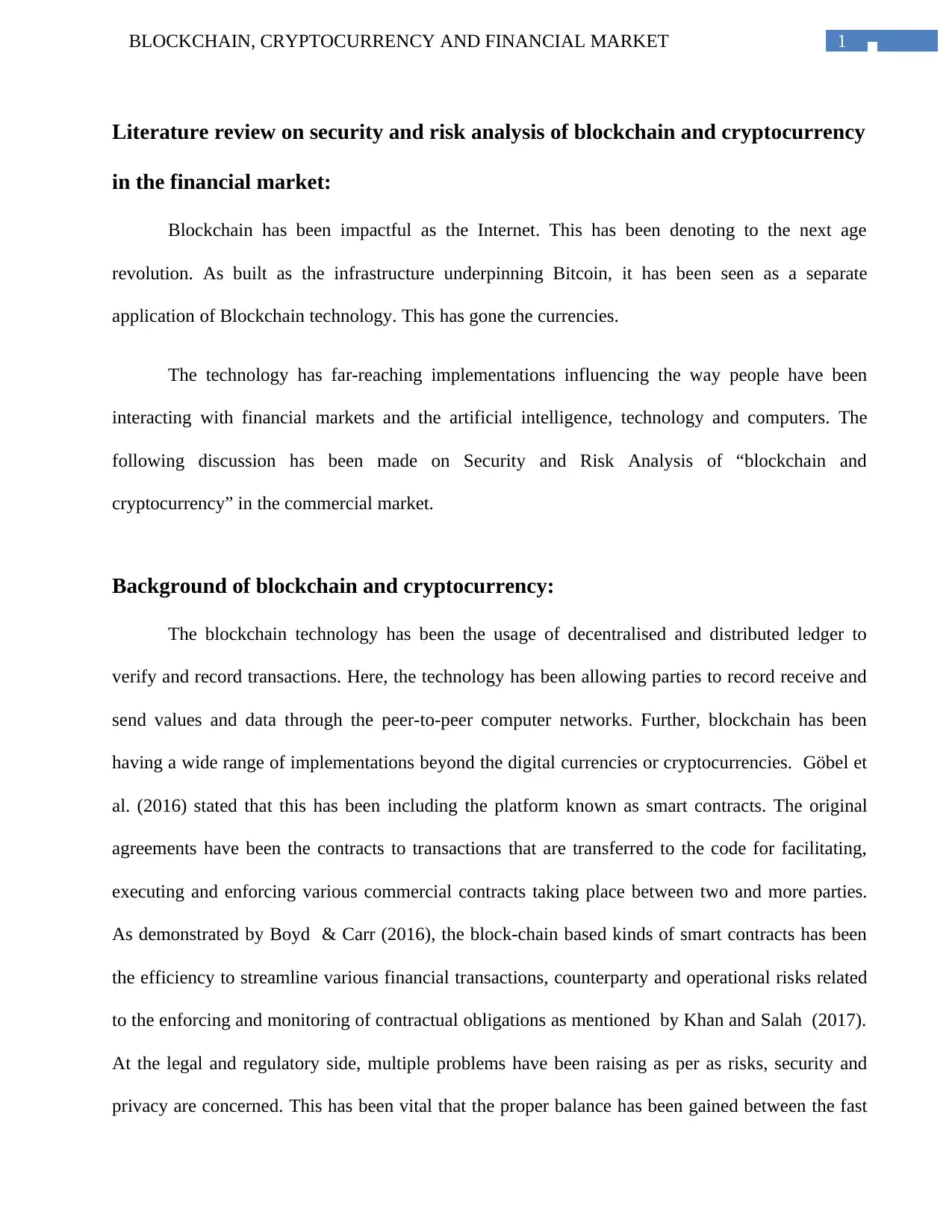
1BLOCKCHAIN, CRYPTOCURRENCY AND FINANCIAL MARKET
Literature review on security and risk analysis of blockchain and cryptocurrency
in the financial market:
Blockchain has been impactful as the Internet. This has been denoting to the next age
revolution. As built as the infrastructure underpinning Bitcoin, it has been seen as a separate
application of Blockchain technology. This has gone the currencies.
The technology has far-reaching implementations influencing the way people have been
interacting with financial markets and the artificial intelligence, technology and computers. The
following discussion has been made on Security and Risk Analysis of “blockchain and
cryptocurrency” in the commercial market.
Background of blockchain and cryptocurrency:
The blockchain technology has been the usage of decentralised and distributed ledger to
verify and record transactions. Here, the technology has been allowing parties to record receive and
send values and data through the peer-to-peer computer networks. Further, blockchain has been
having a wide range of implementations beyond the digital currencies or cryptocurrencies. Göbel et
al. (2016) stated that this has been including the platform known as smart contracts. The original
agreements have been the contracts to transactions that are transferred to the code for facilitating,
executing and enforcing various commercial contracts taking place between two and more parties.
As demonstrated by Boyd & Carr (2016), the block-chain based kinds of smart contracts has been
the efficiency to streamline various financial transactions, counterparty and operational risks related
to the enforcing and monitoring of contractual obligations as mentioned by Khan and Salah (2017).
At the legal and regulatory side, multiple problems have been raising as per as risks, security and
privacy are concerned. This has been vital that the proper balance has been gained between the fast
Literature review on security and risk analysis of blockchain and cryptocurrency
in the financial market:
Blockchain has been impactful as the Internet. This has been denoting to the next age
revolution. As built as the infrastructure underpinning Bitcoin, it has been seen as a separate
application of Blockchain technology. This has gone the currencies.
The technology has far-reaching implementations influencing the way people have been
interacting with financial markets and the artificial intelligence, technology and computers. The
following discussion has been made on Security and Risk Analysis of “blockchain and
cryptocurrency” in the commercial market.
Background of blockchain and cryptocurrency:
The blockchain technology has been the usage of decentralised and distributed ledger to
verify and record transactions. Here, the technology has been allowing parties to record receive and
send values and data through the peer-to-peer computer networks. Further, blockchain has been
having a wide range of implementations beyond the digital currencies or cryptocurrencies. Göbel et
al. (2016) stated that this has been including the platform known as smart contracts. The original
agreements have been the contracts to transactions that are transferred to the code for facilitating,
executing and enforcing various commercial contracts taking place between two and more parties.
As demonstrated by Boyd & Carr (2016), the block-chain based kinds of smart contracts has been
the efficiency to streamline various financial transactions, counterparty and operational risks related
to the enforcing and monitoring of contractual obligations as mentioned by Khan and Salah (2017).
At the legal and regulatory side, multiple problems have been raising as per as risks, security and
privacy are concerned. This has been vital that the proper balance has been gained between the fast
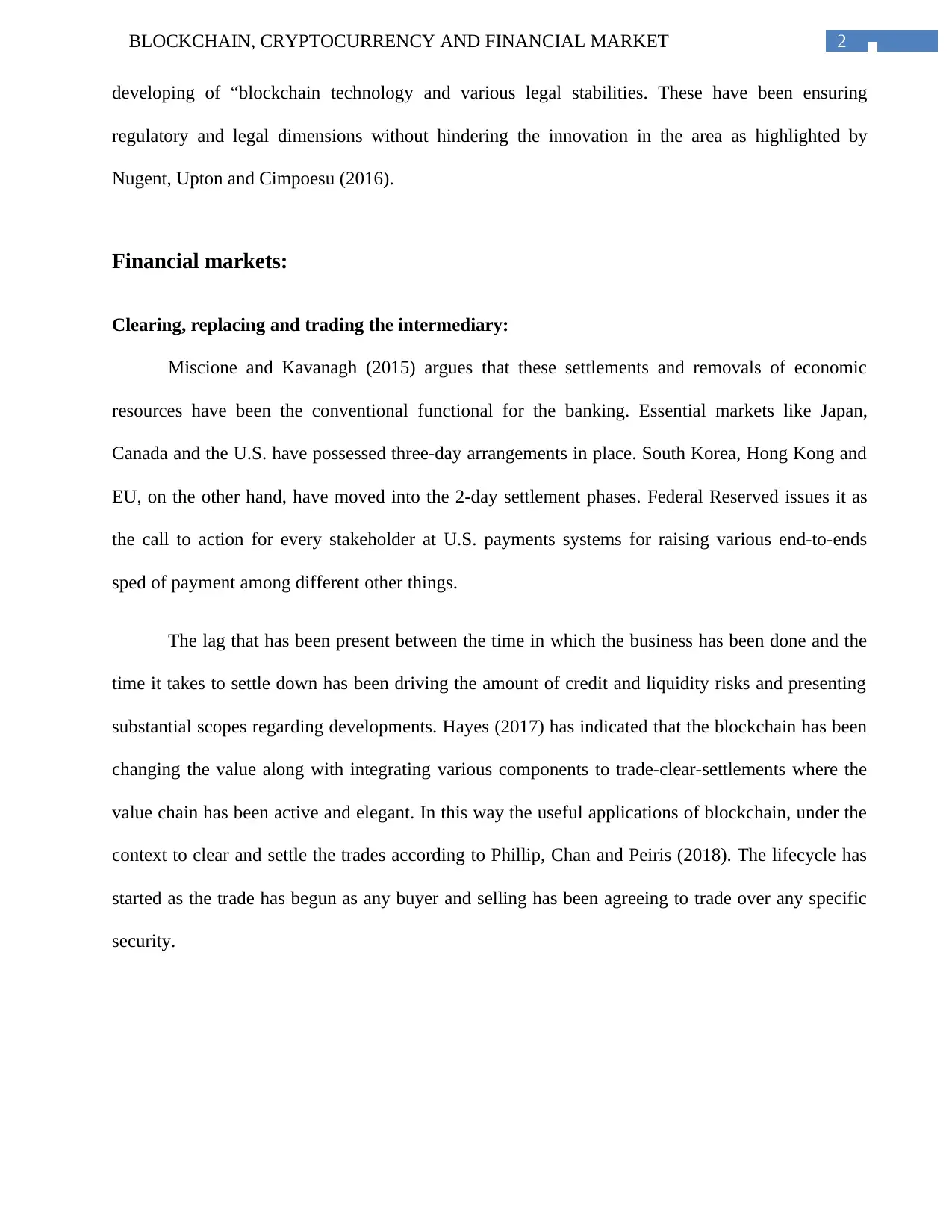
2BLOCKCHAIN, CRYPTOCURRENCY AND FINANCIAL MARKET
developing of “blockchain technology and various legal stabilities. These have been ensuring
regulatory and legal dimensions without hindering the innovation in the area as highlighted by
Nugent, Upton and Cimpoesu (2016).
Financial markets:
Clearing, replacing and trading the intermediary:
Miscione and Kavanagh (2015) argues that these settlements and removals of economic
resources have been the conventional functional for the banking. Essential markets like Japan,
Canada and the U.S. have possessed three-day arrangements in place. South Korea, Hong Kong and
EU, on the other hand, have moved into the 2-day settlement phases. Federal Reserved issues it as
the call to action for every stakeholder at U.S. payments systems for raising various end-to-ends
sped of payment among different other things.
The lag that has been present between the time in which the business has been done and the
time it takes to settle down has been driving the amount of credit and liquidity risks and presenting
substantial scopes regarding developments. Hayes (2017) has indicated that the blockchain has been
changing the value along with integrating various components to trade-clear-settlements where the
value chain has been active and elegant. In this way the useful applications of blockchain, under the
context to clear and settle the trades according to Phillip, Chan and Peiris (2018). The lifecycle has
started as the trade has begun as any buyer and selling has been agreeing to trade over any specific
security.
developing of “blockchain technology and various legal stabilities. These have been ensuring
regulatory and legal dimensions without hindering the innovation in the area as highlighted by
Nugent, Upton and Cimpoesu (2016).
Financial markets:
Clearing, replacing and trading the intermediary:
Miscione and Kavanagh (2015) argues that these settlements and removals of economic
resources have been the conventional functional for the banking. Essential markets like Japan,
Canada and the U.S. have possessed three-day arrangements in place. South Korea, Hong Kong and
EU, on the other hand, have moved into the 2-day settlement phases. Federal Reserved issues it as
the call to action for every stakeholder at U.S. payments systems for raising various end-to-ends
sped of payment among different other things.
The lag that has been present between the time in which the business has been done and the
time it takes to settle down has been driving the amount of credit and liquidity risks and presenting
substantial scopes regarding developments. Hayes (2017) has indicated that the blockchain has been
changing the value along with integrating various components to trade-clear-settlements where the
value chain has been active and elegant. In this way the useful applications of blockchain, under the
context to clear and settle the trades according to Phillip, Chan and Peiris (2018). The lifecycle has
started as the trade has begun as any buyer and selling has been agreeing to trade over any specific
security.
⊘ This is a preview!⊘
Do you want full access?
Subscribe today to unlock all pages.

Trusted by 1+ million students worldwide
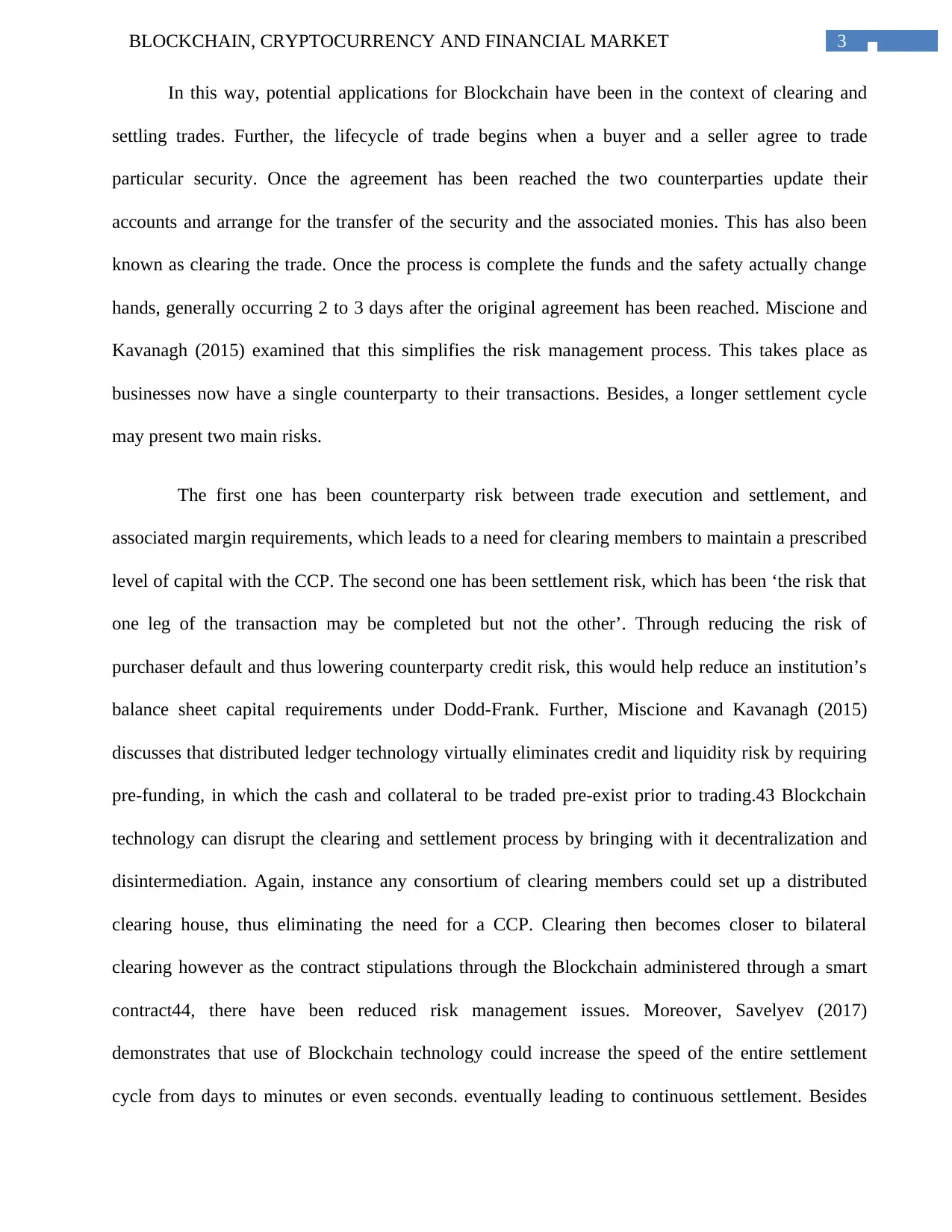
3BLOCKCHAIN, CRYPTOCURRENCY AND FINANCIAL MARKET
In this way, potential applications for Blockchain have been in the context of clearing and
settling trades. Further, the lifecycle of trade begins when a buyer and a seller agree to trade
particular security. Once the agreement has been reached the two counterparties update their
accounts and arrange for the transfer of the security and the associated monies. This has also been
known as clearing the trade. Once the process is complete the funds and the safety actually change
hands, generally occurring 2 to 3 days after the original agreement has been reached. Miscione and
Kavanagh (2015) examined that this simplifies the risk management process. This takes place as
businesses now have a single counterparty to their transactions. Besides, a longer settlement cycle
may present two main risks.
The first one has been counterparty risk between trade execution and settlement, and
associated margin requirements, which leads to a need for clearing members to maintain a prescribed
level of capital with the CCP. The second one has been settlement risk, which has been ‘the risk that
one leg of the transaction may be completed but not the other’. Through reducing the risk of
purchaser default and thus lowering counterparty credit risk, this would help reduce an institution’s
balance sheet capital requirements under Dodd-Frank. Further, Miscione and Kavanagh (2015)
discusses that distributed ledger technology virtually eliminates credit and liquidity risk by requiring
pre-funding, in which the cash and collateral to be traded pre-exist prior to trading.43 Blockchain
technology can disrupt the clearing and settlement process by bringing with it decentralization and
disintermediation. Again, instance any consortium of clearing members could set up a distributed
clearing house, thus eliminating the need for a CCP. Clearing then becomes closer to bilateral
clearing however as the contract stipulations through the Blockchain administered through a smart
contract44, there have been reduced risk management issues. Moreover, Savelyev (2017)
demonstrates that use of Blockchain technology could increase the speed of the entire settlement
cycle from days to minutes or even seconds. eventually leading to continuous settlement. Besides
In this way, potential applications for Blockchain have been in the context of clearing and
settling trades. Further, the lifecycle of trade begins when a buyer and a seller agree to trade
particular security. Once the agreement has been reached the two counterparties update their
accounts and arrange for the transfer of the security and the associated monies. This has also been
known as clearing the trade. Once the process is complete the funds and the safety actually change
hands, generally occurring 2 to 3 days after the original agreement has been reached. Miscione and
Kavanagh (2015) examined that this simplifies the risk management process. This takes place as
businesses now have a single counterparty to their transactions. Besides, a longer settlement cycle
may present two main risks.
The first one has been counterparty risk between trade execution and settlement, and
associated margin requirements, which leads to a need for clearing members to maintain a prescribed
level of capital with the CCP. The second one has been settlement risk, which has been ‘the risk that
one leg of the transaction may be completed but not the other’. Through reducing the risk of
purchaser default and thus lowering counterparty credit risk, this would help reduce an institution’s
balance sheet capital requirements under Dodd-Frank. Further, Miscione and Kavanagh (2015)
discusses that distributed ledger technology virtually eliminates credit and liquidity risk by requiring
pre-funding, in which the cash and collateral to be traded pre-exist prior to trading.43 Blockchain
technology can disrupt the clearing and settlement process by bringing with it decentralization and
disintermediation. Again, instance any consortium of clearing members could set up a distributed
clearing house, thus eliminating the need for a CCP. Clearing then becomes closer to bilateral
clearing however as the contract stipulations through the Blockchain administered through a smart
contract44, there have been reduced risk management issues. Moreover, Savelyev (2017)
demonstrates that use of Blockchain technology could increase the speed of the entire settlement
cycle from days to minutes or even seconds. eventually leading to continuous settlement. Besides
Paraphrase This Document
Need a fresh take? Get an instant paraphrase of this document with our AI Paraphraser
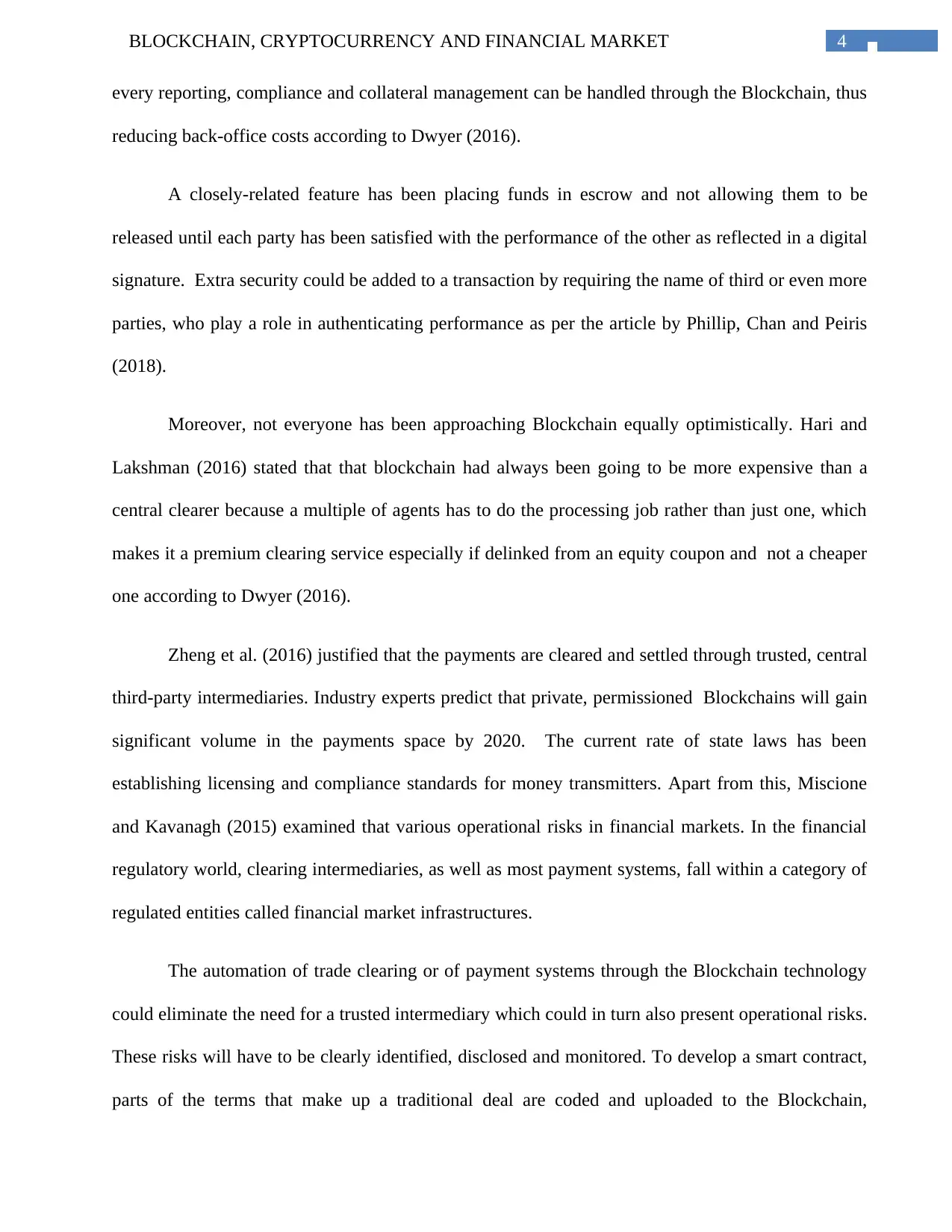
4BLOCKCHAIN, CRYPTOCURRENCY AND FINANCIAL MARKET
every reporting, compliance and collateral management can be handled through the Blockchain, thus
reducing back-office costs according to Dwyer (2016).
A closely-related feature has been placing funds in escrow and not allowing them to be
released until each party has been satisfied with the performance of the other as reflected in a digital
signature. Extra security could be added to a transaction by requiring the name of third or even more
parties, who play a role in authenticating performance as per the article by Phillip, Chan and Peiris
(2018).
Moreover, not everyone has been approaching Blockchain equally optimistically. Hari and
Lakshman (2016) stated that that blockchain had always been going to be more expensive than a
central clearer because a multiple of agents has to do the processing job rather than just one, which
makes it a premium clearing service especially if delinked from an equity coupon and not a cheaper
one according to Dwyer (2016).
Zheng et al. (2016) justified that the payments are cleared and settled through trusted, central
third-party intermediaries. Industry experts predict that private, permissioned Blockchains will gain
significant volume in the payments space by 2020. The current rate of state laws has been
establishing licensing and compliance standards for money transmitters. Apart from this, Miscione
and Kavanagh (2015) examined that various operational risks in financial markets. In the financial
regulatory world, clearing intermediaries, as well as most payment systems, fall within a category of
regulated entities called financial market infrastructures.
The automation of trade clearing or of payment systems through the Blockchain technology
could eliminate the need for a trusted intermediary which could in turn also present operational risks.
These risks will have to be clearly identified, disclosed and monitored. To develop a smart contract,
parts of the terms that make up a traditional deal are coded and uploaded to the Blockchain,
every reporting, compliance and collateral management can be handled through the Blockchain, thus
reducing back-office costs according to Dwyer (2016).
A closely-related feature has been placing funds in escrow and not allowing them to be
released until each party has been satisfied with the performance of the other as reflected in a digital
signature. Extra security could be added to a transaction by requiring the name of third or even more
parties, who play a role in authenticating performance as per the article by Phillip, Chan and Peiris
(2018).
Moreover, not everyone has been approaching Blockchain equally optimistically. Hari and
Lakshman (2016) stated that that blockchain had always been going to be more expensive than a
central clearer because a multiple of agents has to do the processing job rather than just one, which
makes it a premium clearing service especially if delinked from an equity coupon and not a cheaper
one according to Dwyer (2016).
Zheng et al. (2016) justified that the payments are cleared and settled through trusted, central
third-party intermediaries. Industry experts predict that private, permissioned Blockchains will gain
significant volume in the payments space by 2020. The current rate of state laws has been
establishing licensing and compliance standards for money transmitters. Apart from this, Miscione
and Kavanagh (2015) examined that various operational risks in financial markets. In the financial
regulatory world, clearing intermediaries, as well as most payment systems, fall within a category of
regulated entities called financial market infrastructures.
The automation of trade clearing or of payment systems through the Blockchain technology
could eliminate the need for a trusted intermediary which could in turn also present operational risks.
These risks will have to be clearly identified, disclosed and monitored. To develop a smart contract,
parts of the terms that make up a traditional deal are coded and uploaded to the Blockchain,
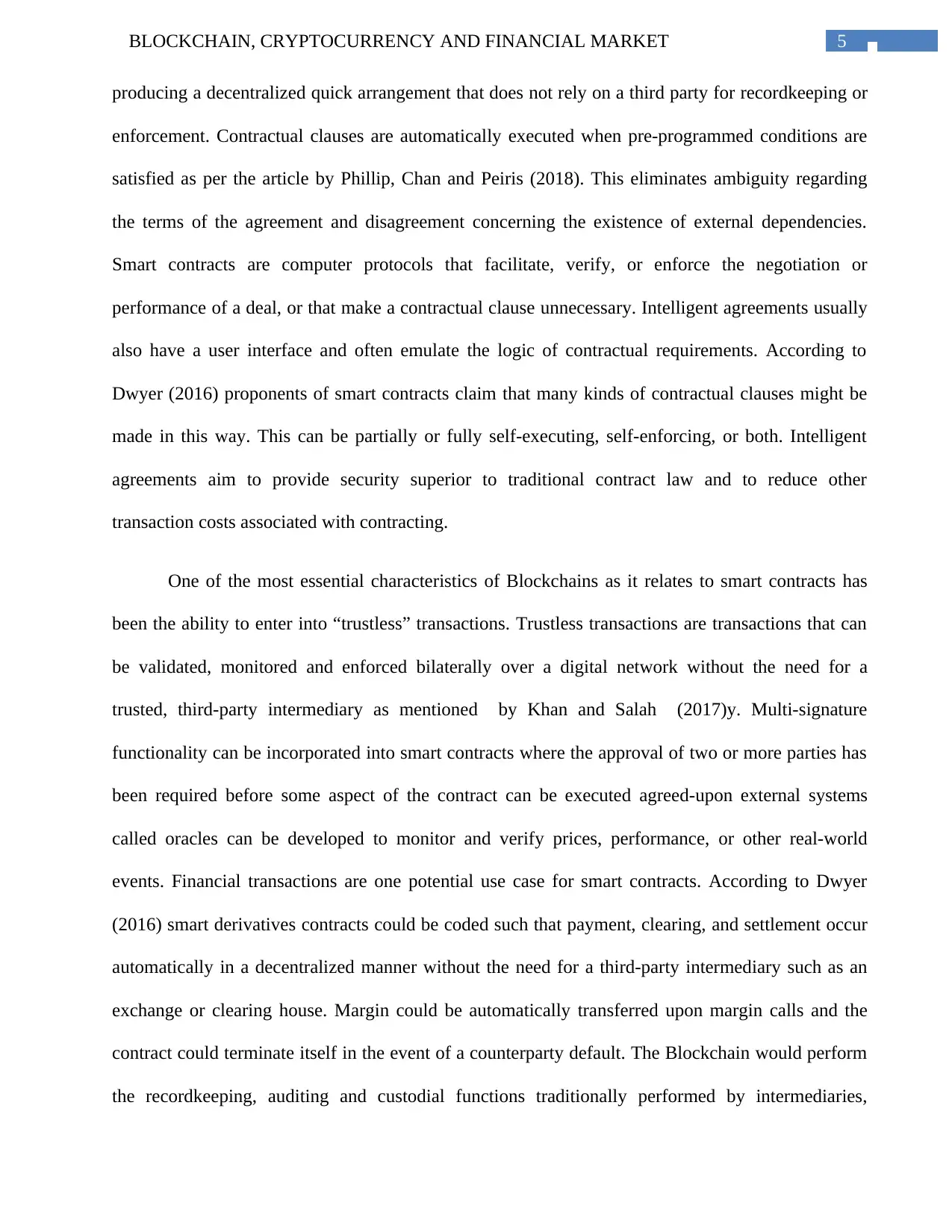
5BLOCKCHAIN, CRYPTOCURRENCY AND FINANCIAL MARKET
producing a decentralized quick arrangement that does not rely on a third party for recordkeeping or
enforcement. Contractual clauses are automatically executed when pre-programmed conditions are
satisfied as per the article by Phillip, Chan and Peiris (2018). This eliminates ambiguity regarding
the terms of the agreement and disagreement concerning the existence of external dependencies.
Smart contracts are computer protocols that facilitate, verify, or enforce the negotiation or
performance of a deal, or that make a contractual clause unnecessary. Intelligent agreements usually
also have a user interface and often emulate the logic of contractual requirements. According to
Dwyer (2016) proponents of smart contracts claim that many kinds of contractual clauses might be
made in this way. This can be partially or fully self-executing, self-enforcing, or both. Intelligent
agreements aim to provide security superior to traditional contract law and to reduce other
transaction costs associated with contracting.
One of the most essential characteristics of Blockchains as it relates to smart contracts has
been the ability to enter into “trustless” transactions. Trustless transactions are transactions that can
be validated, monitored and enforced bilaterally over a digital network without the need for a
trusted, third-party intermediary as mentioned by Khan and Salah (2017)y. Multi-signature
functionality can be incorporated into smart contracts where the approval of two or more parties has
been required before some aspect of the contract can be executed agreed-upon external systems
called oracles can be developed to monitor and verify prices, performance, or other real-world
events. Financial transactions are one potential use case for smart contracts. According to Dwyer
(2016) smart derivatives contracts could be coded such that payment, clearing, and settlement occur
automatically in a decentralized manner without the need for a third-party intermediary such as an
exchange or clearing house. Margin could be automatically transferred upon margin calls and the
contract could terminate itself in the event of a counterparty default. The Blockchain would perform
the recordkeeping, auditing and custodial functions traditionally performed by intermediaries,
producing a decentralized quick arrangement that does not rely on a third party for recordkeeping or
enforcement. Contractual clauses are automatically executed when pre-programmed conditions are
satisfied as per the article by Phillip, Chan and Peiris (2018). This eliminates ambiguity regarding
the terms of the agreement and disagreement concerning the existence of external dependencies.
Smart contracts are computer protocols that facilitate, verify, or enforce the negotiation or
performance of a deal, or that make a contractual clause unnecessary. Intelligent agreements usually
also have a user interface and often emulate the logic of contractual requirements. According to
Dwyer (2016) proponents of smart contracts claim that many kinds of contractual clauses might be
made in this way. This can be partially or fully self-executing, self-enforcing, or both. Intelligent
agreements aim to provide security superior to traditional contract law and to reduce other
transaction costs associated with contracting.
One of the most essential characteristics of Blockchains as it relates to smart contracts has
been the ability to enter into “trustless” transactions. Trustless transactions are transactions that can
be validated, monitored and enforced bilaterally over a digital network without the need for a
trusted, third-party intermediary as mentioned by Khan and Salah (2017)y. Multi-signature
functionality can be incorporated into smart contracts where the approval of two or more parties has
been required before some aspect of the contract can be executed agreed-upon external systems
called oracles can be developed to monitor and verify prices, performance, or other real-world
events. Financial transactions are one potential use case for smart contracts. According to Dwyer
(2016) smart derivatives contracts could be coded such that payment, clearing, and settlement occur
automatically in a decentralized manner without the need for a third-party intermediary such as an
exchange or clearing house. Margin could be automatically transferred upon margin calls and the
contract could terminate itself in the event of a counterparty default. The Blockchain would perform
the recordkeeping, auditing and custodial functions traditionally performed by intermediaries,
⊘ This is a preview!⊘
Do you want full access?
Subscribe today to unlock all pages.

Trusted by 1+ million students worldwide
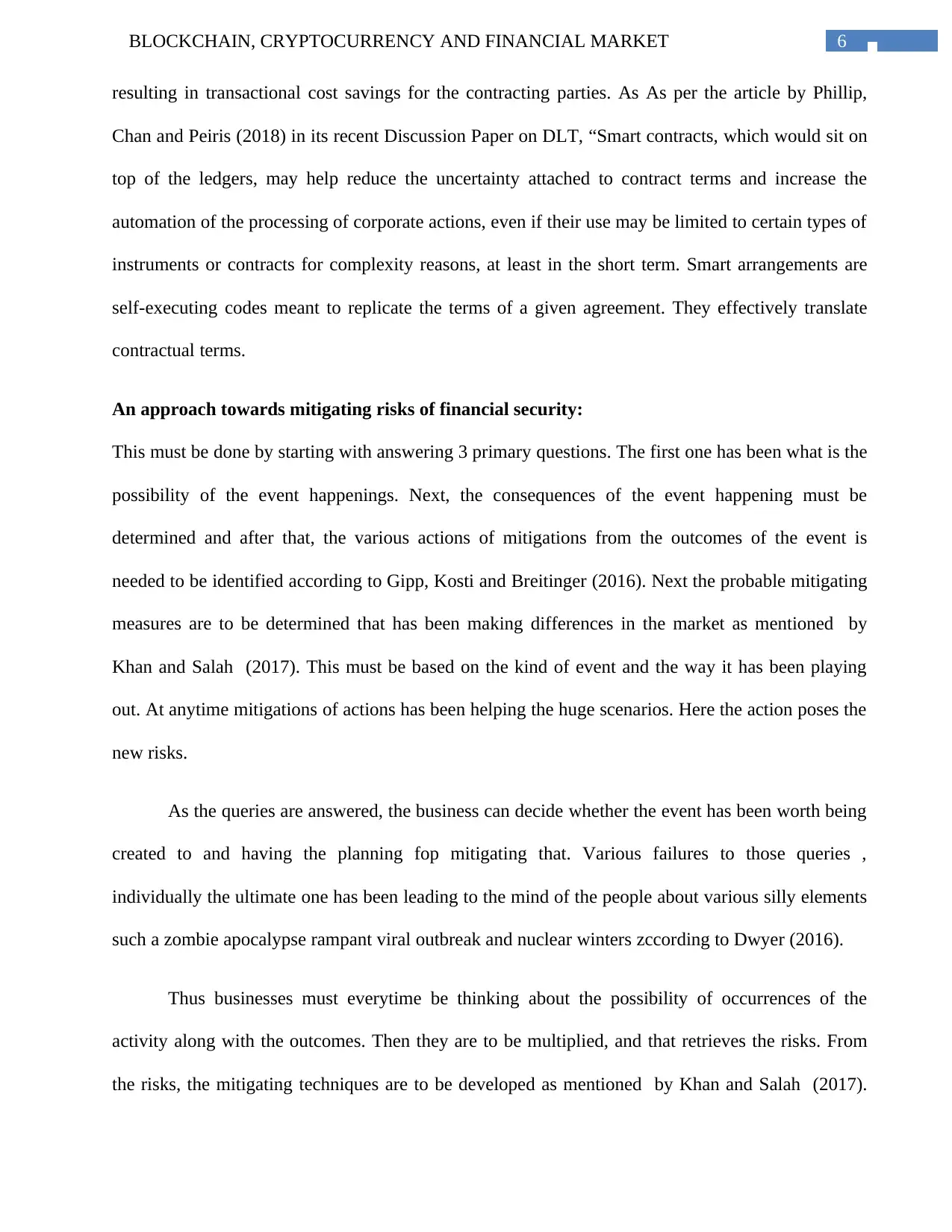
6BLOCKCHAIN, CRYPTOCURRENCY AND FINANCIAL MARKET
resulting in transactional cost savings for the contracting parties. As As per the article by Phillip,
Chan and Peiris (2018) in its recent Discussion Paper on DLT, “Smart contracts, which would sit on
top of the ledgers, may help reduce the uncertainty attached to contract terms and increase the
automation of the processing of corporate actions, even if their use may be limited to certain types of
instruments or contracts for complexity reasons, at least in the short term. Smart arrangements are
self-executing codes meant to replicate the terms of a given agreement. They effectively translate
contractual terms.
An approach towards mitigating risks of financial security:
This must be done by starting with answering 3 primary questions. The first one has been what is the
possibility of the event happenings. Next, the consequences of the event happening must be
determined and after that, the various actions of mitigations from the outcomes of the event is
needed to be identified according to Gipp, Kosti and Breitinger (2016). Next the probable mitigating
measures are to be determined that has been making differences in the market as mentioned by
Khan and Salah (2017). This must be based on the kind of event and the way it has been playing
out. At anytime mitigations of actions has been helping the huge scenarios. Here the action poses the
new risks.
As the queries are answered, the business can decide whether the event has been worth being
created to and having the planning fop mitigating that. Various failures to those queries ,
individually the ultimate one has been leading to the mind of the people about various silly elements
such a zombie apocalypse rampant viral outbreak and nuclear winters zccording to Dwyer (2016).
Thus businesses must everytime be thinking about the possibility of occurrences of the
activity along with the outcomes. Then they are to be multiplied, and that retrieves the risks. From
the risks, the mitigating techniques are to be developed as mentioned by Khan and Salah (2017).
resulting in transactional cost savings for the contracting parties. As As per the article by Phillip,
Chan and Peiris (2018) in its recent Discussion Paper on DLT, “Smart contracts, which would sit on
top of the ledgers, may help reduce the uncertainty attached to contract terms and increase the
automation of the processing of corporate actions, even if their use may be limited to certain types of
instruments or contracts for complexity reasons, at least in the short term. Smart arrangements are
self-executing codes meant to replicate the terms of a given agreement. They effectively translate
contractual terms.
An approach towards mitigating risks of financial security:
This must be done by starting with answering 3 primary questions. The first one has been what is the
possibility of the event happenings. Next, the consequences of the event happening must be
determined and after that, the various actions of mitigations from the outcomes of the event is
needed to be identified according to Gipp, Kosti and Breitinger (2016). Next the probable mitigating
measures are to be determined that has been making differences in the market as mentioned by
Khan and Salah (2017). This must be based on the kind of event and the way it has been playing
out. At anytime mitigations of actions has been helping the huge scenarios. Here the action poses the
new risks.
As the queries are answered, the business can decide whether the event has been worth being
created to and having the planning fop mitigating that. Various failures to those queries ,
individually the ultimate one has been leading to the mind of the people about various silly elements
such a zombie apocalypse rampant viral outbreak and nuclear winters zccording to Dwyer (2016).
Thus businesses must everytime be thinking about the possibility of occurrences of the
activity along with the outcomes. Then they are to be multiplied, and that retrieves the risks. From
the risks, the mitigating techniques are to be developed as mentioned by Khan and Salah (2017).
Paraphrase This Document
Need a fresh take? Get an instant paraphrase of this document with our AI Paraphraser
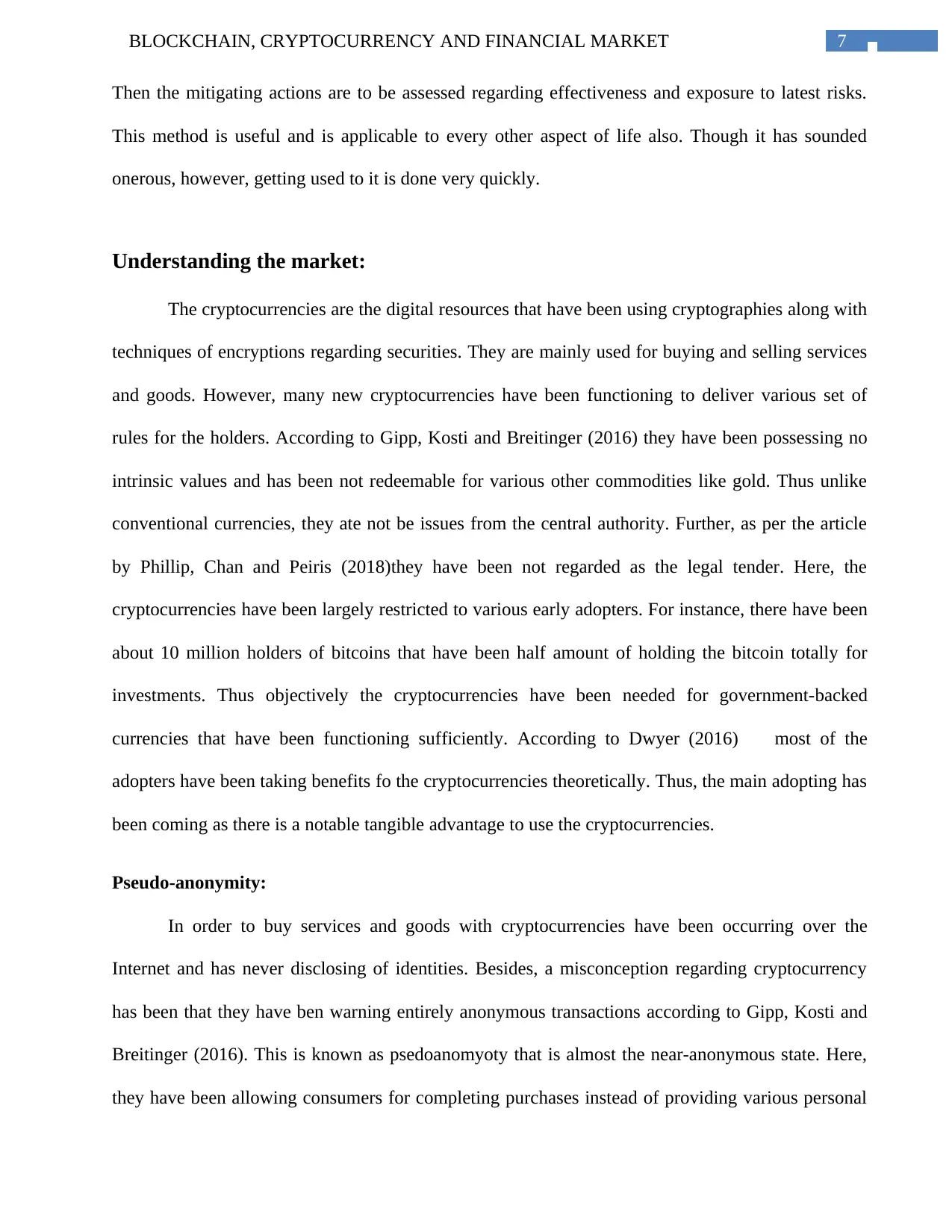
7BLOCKCHAIN, CRYPTOCURRENCY AND FINANCIAL MARKET
Then the mitigating actions are to be assessed regarding effectiveness and exposure to latest risks.
This method is useful and is applicable to every other aspect of life also. Though it has sounded
onerous, however, getting used to it is done very quickly.
Understanding the market:
The cryptocurrencies are the digital resources that have been using cryptographies along with
techniques of encryptions regarding securities. They are mainly used for buying and selling services
and goods. However, many new cryptocurrencies have been functioning to deliver various set of
rules for the holders. According to Gipp, Kosti and Breitinger (2016) they have been possessing no
intrinsic values and has been not redeemable for various other commodities like gold. Thus unlike
conventional currencies, they ate not be issues from the central authority. Further, as per the article
by Phillip, Chan and Peiris (2018)they have been not regarded as the legal tender. Here, the
cryptocurrencies have been largely restricted to various early adopters. For instance, there have been
about 10 million holders of bitcoins that have been half amount of holding the bitcoin totally for
investments. Thus objectively the cryptocurrencies have been needed for government-backed
currencies that have been functioning sufficiently. According to Dwyer (2016) most of the
adopters have been taking benefits fo the cryptocurrencies theoretically. Thus, the main adopting has
been coming as there is a notable tangible advantage to use the cryptocurrencies.
Pseudo-anonymity:
In order to buy services and goods with cryptocurrencies have been occurring over the
Internet and has never disclosing of identities. Besides, a misconception regarding cryptocurrency
has been that they have ben warning entirely anonymous transactions according to Gipp, Kosti and
Breitinger (2016). This is known as psedoanomyoty that is almost the near-anonymous state. Here,
they have been allowing consumers for completing purchases instead of providing various personal
Then the mitigating actions are to be assessed regarding effectiveness and exposure to latest risks.
This method is useful and is applicable to every other aspect of life also. Though it has sounded
onerous, however, getting used to it is done very quickly.
Understanding the market:
The cryptocurrencies are the digital resources that have been using cryptographies along with
techniques of encryptions regarding securities. They are mainly used for buying and selling services
and goods. However, many new cryptocurrencies have been functioning to deliver various set of
rules for the holders. According to Gipp, Kosti and Breitinger (2016) they have been possessing no
intrinsic values and has been not redeemable for various other commodities like gold. Thus unlike
conventional currencies, they ate not be issues from the central authority. Further, as per the article
by Phillip, Chan and Peiris (2018)they have been not regarded as the legal tender. Here, the
cryptocurrencies have been largely restricted to various early adopters. For instance, there have been
about 10 million holders of bitcoins that have been half amount of holding the bitcoin totally for
investments. Thus objectively the cryptocurrencies have been needed for government-backed
currencies that have been functioning sufficiently. According to Dwyer (2016) most of the
adopters have been taking benefits fo the cryptocurrencies theoretically. Thus, the main adopting has
been coming as there is a notable tangible advantage to use the cryptocurrencies.
Pseudo-anonymity:
In order to buy services and goods with cryptocurrencies have been occurring over the
Internet and has never disclosing of identities. Besides, a misconception regarding cryptocurrency
has been that they have ben warning entirely anonymous transactions according to Gipp, Kosti and
Breitinger (2016). This is known as psedoanomyoty that is almost the near-anonymous state. Here,
they have been allowing consumers for completing purchases instead of providing various personal
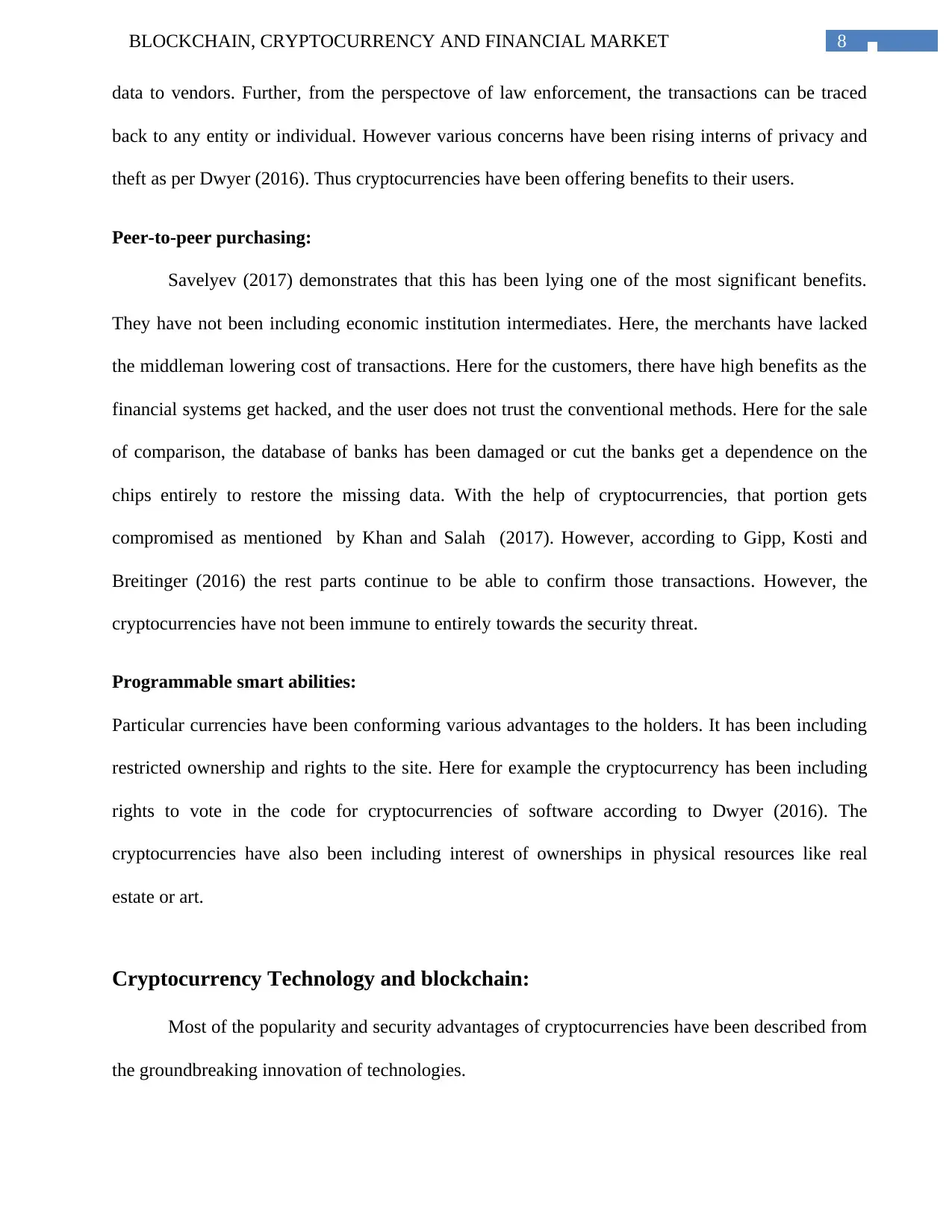
8BLOCKCHAIN, CRYPTOCURRENCY AND FINANCIAL MARKET
data to vendors. Further, from the perspectove of law enforcement, the transactions can be traced
back to any entity or individual. However various concerns have been rising interns of privacy and
theft as per Dwyer (2016). Thus cryptocurrencies have been offering benefits to their users.
Peer-to-peer purchasing:
Savelyev (2017) demonstrates that this has been lying one of the most significant benefits.
They have not been including economic institution intermediates. Here, the merchants have lacked
the middleman lowering cost of transactions. Here for the customers, there have high benefits as the
financial systems get hacked, and the user does not trust the conventional methods. Here for the sale
of comparison, the database of banks has been damaged or cut the banks get a dependence on the
chips entirely to restore the missing data. With the help of cryptocurrencies, that portion gets
compromised as mentioned by Khan and Salah (2017). However, according to Gipp, Kosti and
Breitinger (2016) the rest parts continue to be able to confirm those transactions. However, the
cryptocurrencies have not been immune to entirely towards the security threat.
Programmable smart abilities:
Particular currencies have been conforming various advantages to the holders. It has been including
restricted ownership and rights to the site. Here for example the cryptocurrency has been including
rights to vote in the code for cryptocurrencies of software according to Dwyer (2016). The
cryptocurrencies have also been including interest of ownerships in physical resources like real
estate or art.
Cryptocurrency Technology and blockchain:
Most of the popularity and security advantages of cryptocurrencies have been described from
the groundbreaking innovation of technologies.
data to vendors. Further, from the perspectove of law enforcement, the transactions can be traced
back to any entity or individual. However various concerns have been rising interns of privacy and
theft as per Dwyer (2016). Thus cryptocurrencies have been offering benefits to their users.
Peer-to-peer purchasing:
Savelyev (2017) demonstrates that this has been lying one of the most significant benefits.
They have not been including economic institution intermediates. Here, the merchants have lacked
the middleman lowering cost of transactions. Here for the customers, there have high benefits as the
financial systems get hacked, and the user does not trust the conventional methods. Here for the sale
of comparison, the database of banks has been damaged or cut the banks get a dependence on the
chips entirely to restore the missing data. With the help of cryptocurrencies, that portion gets
compromised as mentioned by Khan and Salah (2017). However, according to Gipp, Kosti and
Breitinger (2016) the rest parts continue to be able to confirm those transactions. However, the
cryptocurrencies have not been immune to entirely towards the security threat.
Programmable smart abilities:
Particular currencies have been conforming various advantages to the holders. It has been including
restricted ownership and rights to the site. Here for example the cryptocurrency has been including
rights to vote in the code for cryptocurrencies of software according to Dwyer (2016). The
cryptocurrencies have also been including interest of ownerships in physical resources like real
estate or art.
Cryptocurrency Technology and blockchain:
Most of the popularity and security advantages of cryptocurrencies have been described from
the groundbreaking innovation of technologies.
⊘ This is a preview!⊘
Do you want full access?
Subscribe today to unlock all pages.

Trusted by 1+ million students worldwide
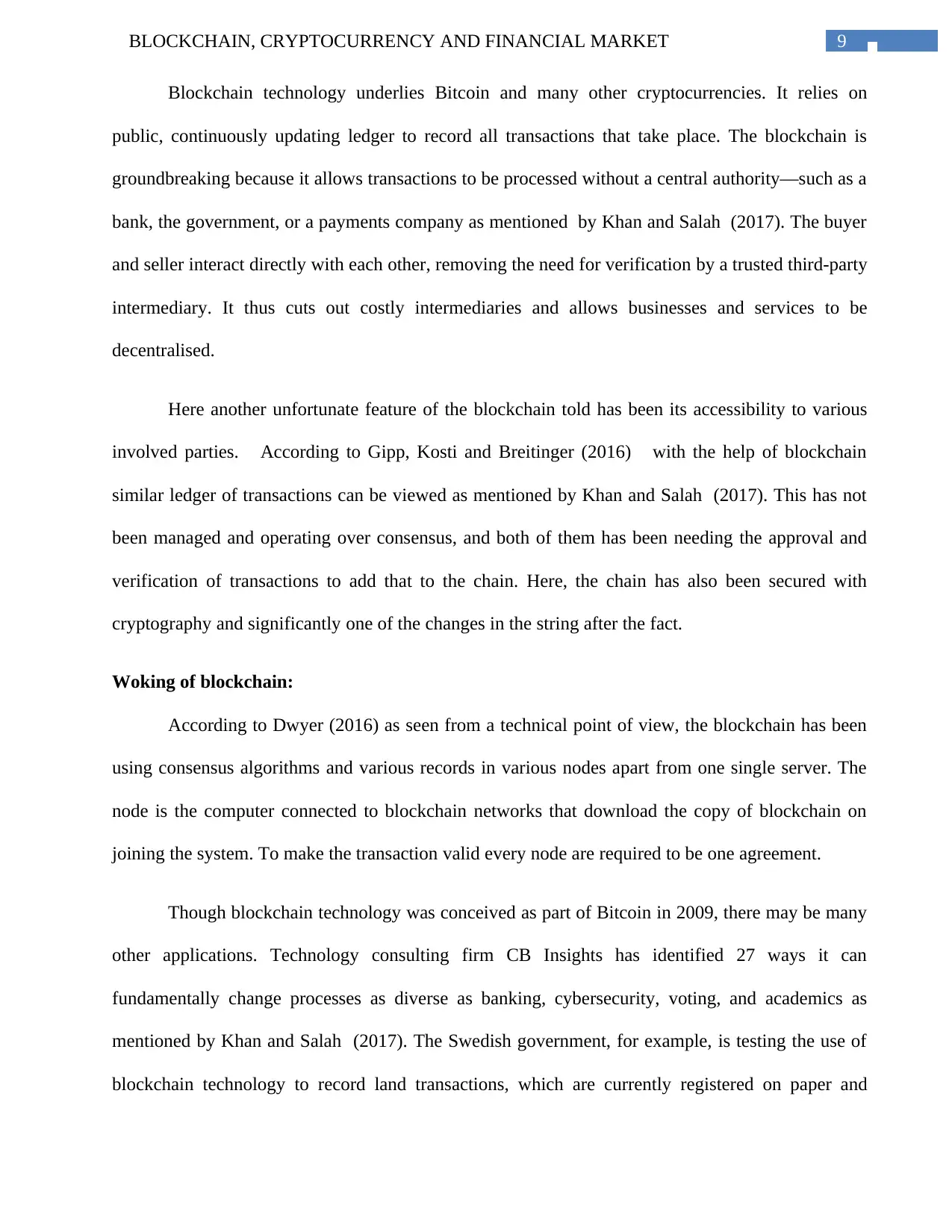
9BLOCKCHAIN, CRYPTOCURRENCY AND FINANCIAL MARKET
Blockchain technology underlies Bitcoin and many other cryptocurrencies. It relies on
public, continuously updating ledger to record all transactions that take place. The blockchain is
groundbreaking because it allows transactions to be processed without a central authority—such as a
bank, the government, or a payments company as mentioned by Khan and Salah (2017). The buyer
and seller interact directly with each other, removing the need for verification by a trusted third-party
intermediary. It thus cuts out costly intermediaries and allows businesses and services to be
decentralised.
Here another unfortunate feature of the blockchain told has been its accessibility to various
involved parties. According to Gipp, Kosti and Breitinger (2016) with the help of blockchain
similar ledger of transactions can be viewed as mentioned by Khan and Salah (2017). This has not
been managed and operating over consensus, and both of them has been needing the approval and
verification of transactions to add that to the chain. Here, the chain has also been secured with
cryptography and significantly one of the changes in the string after the fact.
Woking of blockchain:
According to Dwyer (2016) as seen from a technical point of view, the blockchain has been
using consensus algorithms and various records in various nodes apart from one single server. The
node is the computer connected to blockchain networks that download the copy of blockchain on
joining the system. To make the transaction valid every node are required to be one agreement.
Though blockchain technology was conceived as part of Bitcoin in 2009, there may be many
other applications. Technology consulting firm CB Insights has identified 27 ways it can
fundamentally change processes as diverse as banking, cybersecurity, voting, and academics as
mentioned by Khan and Salah (2017). The Swedish government, for example, is testing the use of
blockchain technology to record land transactions, which are currently registered on paper and
Blockchain technology underlies Bitcoin and many other cryptocurrencies. It relies on
public, continuously updating ledger to record all transactions that take place. The blockchain is
groundbreaking because it allows transactions to be processed without a central authority—such as a
bank, the government, or a payments company as mentioned by Khan and Salah (2017). The buyer
and seller interact directly with each other, removing the need for verification by a trusted third-party
intermediary. It thus cuts out costly intermediaries and allows businesses and services to be
decentralised.
Here another unfortunate feature of the blockchain told has been its accessibility to various
involved parties. According to Gipp, Kosti and Breitinger (2016) with the help of blockchain
similar ledger of transactions can be viewed as mentioned by Khan and Salah (2017). This has not
been managed and operating over consensus, and both of them has been needing the approval and
verification of transactions to add that to the chain. Here, the chain has also been secured with
cryptography and significantly one of the changes in the string after the fact.
Woking of blockchain:
According to Dwyer (2016) as seen from a technical point of view, the blockchain has been
using consensus algorithms and various records in various nodes apart from one single server. The
node is the computer connected to blockchain networks that download the copy of blockchain on
joining the system. To make the transaction valid every node are required to be one agreement.
Though blockchain technology was conceived as part of Bitcoin in 2009, there may be many
other applications. Technology consulting firm CB Insights has identified 27 ways it can
fundamentally change processes as diverse as banking, cybersecurity, voting, and academics as
mentioned by Khan and Salah (2017). The Swedish government, for example, is testing the use of
blockchain technology to record land transactions, which are currently registered on paper and
Paraphrase This Document
Need a fresh take? Get an instant paraphrase of this document with our AI Paraphraser

10BLOCKCHAIN, CRYPTOCURRENCY AND FINANCIAL MARKET
transmitted through physical mail. The World Economic Forum estimates that by 2027, 10% of
global GDP will be stored on blockchain technology.
Cryptocurrency Mining:
According to Gipp, Kosti and Breitinger (2016) it refers to a step whereby two things occur:
Cryptocurrency transactions are verified, and new units of the cryptocurrency are created. Useful
mining requires both powerful hardware and software. When it comes to verification, Savelyev
(2017) demonstrates that an individual computer isn’t powerful enough to profitably mine
cryptocurrencies because you’d run up your power bill. To address this, miners often join pools to
increase collective computing power, allocating miner profits to participants. According to Dwyer
(2016) groups of miners compete to verify pending transactions and reap the benefits, leveraging
specialised hardware and cheap electricity. This competition helps to ensure the integrity of
operations.The largest pools include AntPool, F2Pool, and BitFury, with AntPool alone controlling
over 19% of all mining as mentioned by Khan and Salah (2017). Most mining pools are located in
China, comprising more than 70% of total Bitcoin mining. China manufactures most cryptocurrency
mining equipment and leverages the country’s low electricity prices.
Cryptocurrency Exchanges:
These are the sites where people buys, sells and exchanges them against digital currencies or
conventional currencies. Here, the exchanges can convert cryptocurrencies to main currencies that
are backed by governments. Savelyev (2017) demonstrates that some of the largest exchanges
include Poloniex, Bitfinex, Kraken, and GDAX, which can trade more than $100 million per day.
Almost every transaction is subject to government anti-money laundering regulations, and customers
are required to provide proof of identity when opening an account. Apart from the exchanges, Göbel
et al. (2016) stated that the people have been at many times using P-2-P transactions through various
transmitted through physical mail. The World Economic Forum estimates that by 2027, 10% of
global GDP will be stored on blockchain technology.
Cryptocurrency Mining:
According to Gipp, Kosti and Breitinger (2016) it refers to a step whereby two things occur:
Cryptocurrency transactions are verified, and new units of the cryptocurrency are created. Useful
mining requires both powerful hardware and software. When it comes to verification, Savelyev
(2017) demonstrates that an individual computer isn’t powerful enough to profitably mine
cryptocurrencies because you’d run up your power bill. To address this, miners often join pools to
increase collective computing power, allocating miner profits to participants. According to Dwyer
(2016) groups of miners compete to verify pending transactions and reap the benefits, leveraging
specialised hardware and cheap electricity. This competition helps to ensure the integrity of
operations.The largest pools include AntPool, F2Pool, and BitFury, with AntPool alone controlling
over 19% of all mining as mentioned by Khan and Salah (2017). Most mining pools are located in
China, comprising more than 70% of total Bitcoin mining. China manufactures most cryptocurrency
mining equipment and leverages the country’s low electricity prices.
Cryptocurrency Exchanges:
These are the sites where people buys, sells and exchanges them against digital currencies or
conventional currencies. Here, the exchanges can convert cryptocurrencies to main currencies that
are backed by governments. Savelyev (2017) demonstrates that some of the largest exchanges
include Poloniex, Bitfinex, Kraken, and GDAX, which can trade more than $100 million per day.
Almost every transaction is subject to government anti-money laundering regulations, and customers
are required to provide proof of identity when opening an account. Apart from the exchanges, Göbel
et al. (2016) stated that the people have been at many times using P-2-P transactions through various

11BLOCKCHAIN, CRYPTOCURRENCY AND FINANCIAL MARKET
sites such as LocalBitcoins. They have been using the vendors in avoiding the disclosure personal
data. Here the participants have been trading multiple cryptocurrencies in transactions through
software instead of involving any extra intermediary.
Cryptocurrency wallets:
They are needed for users for sending and receiving various digital currencies and
monitoring the balance. These are the software or hardware and that are regarded to be more secure.
Here, for instance, the ledger wallet has been looking like the USB thumb system connecting to the
USM ports. As these transactions and balances for bitcoins counts have been actual;, the recorded
blockchain as mentioned by Khan and Salah (2017). Here the private keys used have been signing
latest sales that are saved within the wallet. As one tries to develop new transactions, the machines
ask for portfolios for signing that, and then they broadcast the blockchain. As the private key has
never been leaving the wallet of hardware the bitcoins get safe through the computer gets hacked.
However, Göbel et al. (2016) stated that there is any backup, the closing of the wallet results
in a loss of the resources of the holders. This, in contrast, has been the software wallet like Coinbase
wallet has been virtual. Here, these kinds of software devices are placed in the account holder’s
funds over the Internet to possess the purse provide that adds risks. Here for a deeper dive to the
technology powering the cryptocurrencies. Here as per the experts in the industry, there has been one
supreme digital currency. Thos types of crypto-pluralism have been taking the hold. Though the
Ethereum and Bitcoin have comprise the most of the cryptocurrencies marketing sharing that
emergence and growth of various new technologies. This has been in fact the reason that there have
been over 1000 cryptocurrencies that have been existing at now.
sites such as LocalBitcoins. They have been using the vendors in avoiding the disclosure personal
data. Here the participants have been trading multiple cryptocurrencies in transactions through
software instead of involving any extra intermediary.
Cryptocurrency wallets:
They are needed for users for sending and receiving various digital currencies and
monitoring the balance. These are the software or hardware and that are regarded to be more secure.
Here, for instance, the ledger wallet has been looking like the USB thumb system connecting to the
USM ports. As these transactions and balances for bitcoins counts have been actual;, the recorded
blockchain as mentioned by Khan and Salah (2017). Here the private keys used have been signing
latest sales that are saved within the wallet. As one tries to develop new transactions, the machines
ask for portfolios for signing that, and then they broadcast the blockchain. As the private key has
never been leaving the wallet of hardware the bitcoins get safe through the computer gets hacked.
However, Göbel et al. (2016) stated that there is any backup, the closing of the wallet results
in a loss of the resources of the holders. This, in contrast, has been the software wallet like Coinbase
wallet has been virtual. Here, these kinds of software devices are placed in the account holder’s
funds over the Internet to possess the purse provide that adds risks. Here for a deeper dive to the
technology powering the cryptocurrencies. Here as per the experts in the industry, there has been one
supreme digital currency. Thos types of crypto-pluralism have been taking the hold. Though the
Ethereum and Bitcoin have comprise the most of the cryptocurrencies marketing sharing that
emergence and growth of various new technologies. This has been in fact the reason that there have
been over 1000 cryptocurrencies that have been existing at now.
⊘ This is a preview!⊘
Do you want full access?
Subscribe today to unlock all pages.

Trusted by 1+ million students worldwide
1 out of 17
Related Documents
Your All-in-One AI-Powered Toolkit for Academic Success.
+13062052269
info@desklib.com
Available 24*7 on WhatsApp / Email
![[object Object]](/_next/static/media/star-bottom.7253800d.svg)
Unlock your academic potential
Copyright © 2020–2026 A2Z Services. All Rights Reserved. Developed and managed by ZUCOL.




